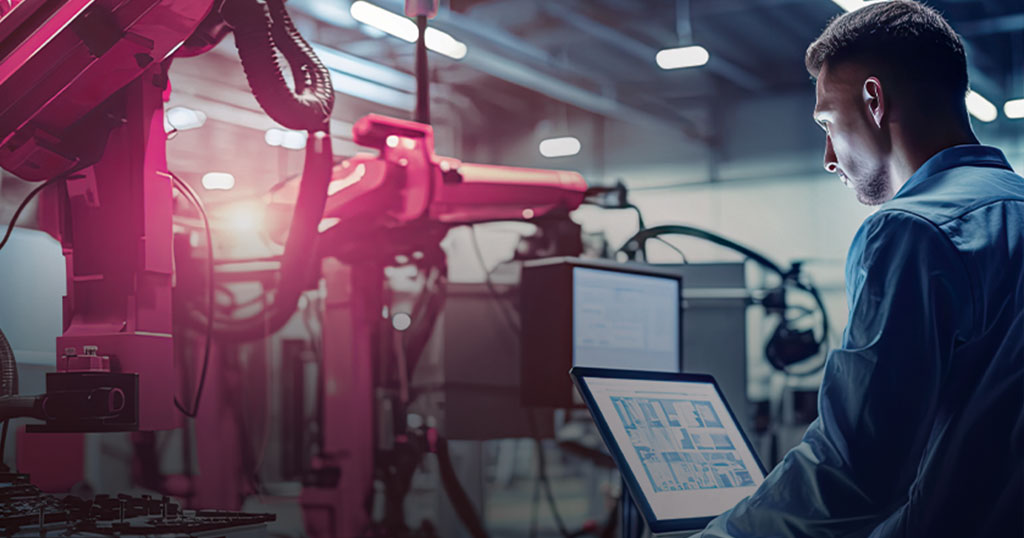Operational Excellence is the ability of a company to continuously improve its value chain in terms of efficiency and effectiveness. It is the ultimate discipline in the manufacturing industry. Companies face constant pressure to optimize their manufacturing processes and increase productivity. However, there are several hurdles to overcome, such as lack of coordination, paper-based processes, and a multitude of labor-intensive manual activities.
For sustainable production optimization, digitalization through Manufacturing Operations Management (MOM) systems is a fundamental cornerstone. It’s crucial that IT activities go hand in hand with the design of processes and methods, and their integration into the shop floor organization, which often faces challenges such as limited resources, skill gaps, and restricted operational capacity.
Based on our project experiences, we have summarized the following typical steps for you to achieve increased OEE (Overall Equipment Effectiveness) and EBIT:
Qualification and involvement
Early involvement of employees as ambassadors significantly contributes to the success of the project. Therefore, the project team and leadership are trained at the project’s outset. This fosters a shared understanding and ensures sustainable integration of activities. Additionally, to assess the coverage of process threads with the standard software and to create mock-ups for the target system as needed, key users must be involved early on.
Equipment and Asset Management
A simple system solution without smart machine integration often generates significant benefits in the initial phase of the project. This is particularly true for maintenance. Asset management documents the condition of the equipment ‘as maintained.’ This allows similar groups of systems to be managed in a standardized manner and to identify deviations (benchmarking). Further potential lies in the standardized spare parts management.
Cross-System Data Logistics
The next step typically involves the integration into company-wide data logistics. To achieve this, leading systems and consumers are identified and matching is designed at their interfaces. Companies should not underestimate this design phase, which is often the most challenging part of establishing a stable data logistics. In terms of technical implementation, certified interfaces for standard systems like SAP are preferable, as individual approaches are often maintenance-intensive and not future-proof.
Optimization of Shop Floor Control
Once order data (from upstream systems) and equipment are available in the MOM system, the optimization of processes surrounding production and shop floor control continues: Error-prone Excel tools are replaced, planning consistency is enhanced, and manual efforts are reduced.
For instance, through effective shop floor data collection (SFDC), operators can report causes and quantities of defects, improving the information basis for control. By digitally providing manufacturing documents, manual efforts and sources of errors can be reduced. All of these measures significantly increase the acceptance of digitally available information among operators.
Machine Integration and Data Preparation
The integration of machines and equipment into the MOM system (Machine Data Acquisition) creates a comprehensive picture of the current manufacturing situation. This enables companies to implement condition-based and predictive maintenance measures. Another particularly important aspect is the implementation of a cross-functional energy management on this basis, as the system provides data for calculating the CO2 footprint throughout the entire production chain.
Digital Shop Floor Management
Digital Shop Floor Management (SFM) serves as a central interface between IT and process optimization. SFM is the key lever for continuous improvement in production and is methodically supported by cascading rule meetings. This allows insights and issues to be visualized and addressed from the workshop floor to the site level, from OEEs and loss reasons at a single facility in one shift to the impact on operational performance and site EBIT.
Stabilizing and Improving OEE
The focus on improving OEE often revolves around reducing downtime and reasons for disruptions. This is based on the consolidated overview from Machine Data Acquisition (MDE) and Shop Floor Data Collection (BDE), identifying measurable causes of losses for each machine. A typical insight, applicable to many companies, is that OEE losses are not solely due to equipment failures but often stem from organizational issues. Therefore, alongside initiatives such as setup workshops, machine cleaning measures, and employee training, projects in office areas are also of significant importance (e.g., order processing, planning/scheduling, and product development/master data).
Enterprise-wide Benefits
Digitization through MOM software establishes a foundation for companies to optimize their production sustainably. In typical cases such as in medium-sized mechanical engineering, improvements of the average OEE across all machines by more than 10 percentage points and an increase in site EBIT by more than 2 percentage points are quite realistic. As long as there are sufficient orders, increased productivity is immediately reflected in higher EBIT. At the same time, improved process quality and responsiveness have a positive impact on customer relationships.

